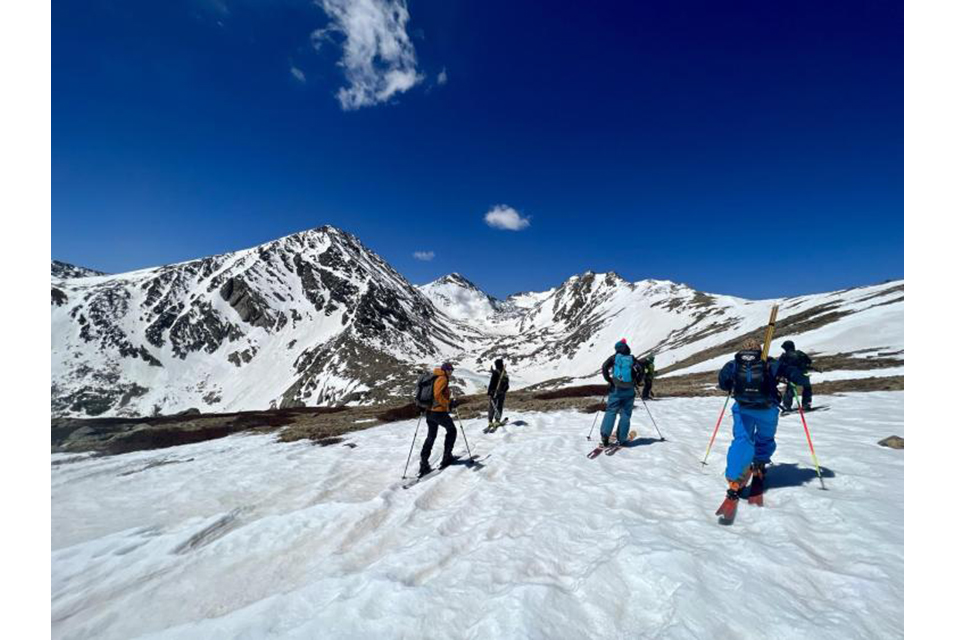BOULDER, CO.- Snow is melting earlier, and more rain is falling instead of snow in the mountain ranges of the Western U.S. and Canada, leading to a leaner snowpack that could impact agriculture, wildfire risk and municipal water supplies come summer, according to a new
CU Boulder analysis.
Published in Nature Communications Earth & Environment, the study documents more than 60 years of change in snowpack water storage across Western North America. It found that from 1950 to 2013, snowpack water storage has significantly declined in more than 25% of the Mountain West, in part because more snow is melting during winter and spring, eroding this seasonal boundary.
“On average and in every mountainous region that we looked at, snow melt is occurring closer in time to when it fell,” said Kate Hale, lead author of the study and a 2022 geography graduate. “The timing of water availability is shifting toward earlier in the springtime, with less snow melt and water availability later in the summertime, suggesting that there will be water scarcity later in the year.”
Timing is everything
The Western U.S. and Canada depend on snow for most of their water. The Rocky Mountains, Sierra Nevadas and other mountain ranges have long served as, essentially, water towers for the region: They store snow throughout the winter, which then melts and becomes available as water in spring and summer, when demand is greatest.
Every year on April 1, state and regional water managers use a metric known as snow water equivalent (SWE)—how much water will be produced when an amount of snow melts—to predict and plan for water resources that year, said Hale, now a postdoctoral researcher at University of Vermont.
But that April 1 snapshot is exactly that: one moment in time. It doesn’t reveal if that snow slowly accumulated over the past six months, if it all fell in one giant heap on March 31, or if it was already melting.
“From a hydrologic perspective, the only thing that's unique about snow is that it delays the timing of water input to watersheds. And just looking at a snapshot of snow water equivalent doesn't give you a sense as to how long that snow water equivalent has been on the ground,” said Noah Molotch, associate professor of geography and fellow at the Institute of Arctic and Alpine Research (INSTAAR) at CU Boulder.
So Hale used two publicly available data sources to develop a new measurement known as Snow Storage Index (SSI) that incorporates the timing and amount of snowfall, as well as snowmelt, before and after April 1. In contrast to the singular moment in time captured by SWE, Hale’s SSI shows a metaphorical video: incorporating into one number, the time between when rain or snow falls on a landscape in the winter season and when it becomes available to that area as surface water.
“The snow storage index allows us to look at snow water storage, not just in the context of how much is there at any given time, but the duration of that storage on the ground,” said Molotch.
This allowed the researchers to analyze how well each mountainous region of the West has acted as a water tower over the past 60 years and discover that their performance has been declining across the board.
Managing water now and for the future
A “high” SSI—a number as close to 1.0 as possible—was found in places where snowfall is very seasonal. In the Cascades, for example, snow accumulates in the fall and winter season, and is stored up to six months before melting somewhat continuously in the spring and summer. Here in Colorado’s Rocky Mountains, however, the SSI is lower—somewhere between 0 and 0.5—which means that snow both accumulates and melts throughout the colder half of the year.
But because the Rockies and the Front Range are already used to this alternating pattern of snowfall and snowmelt during winter and spring seasons, as a region it may adjust easier to similar patterns of decreased snowpack water storage associated with global warming. The mountain regions near the West Coast that are highly reliant on snowpack meltwater in the spring and summer, however, may be in for a painful adjustment when that water melts earlier in the year—and is simply no longer available come late summer.
The researchers hope that this new measurement can serve as a tool for scientists and water resource managers to make better predictions and, when necessary, plan ahead for less.
Half a century ago, an era of dam building in the Western United States allowed the region to flourish in terms of access to water for cities and for agriculture, said Molotch. But as these “water towers” melt away, so too may the reservoirs they filled.
“The snowpack is eroding and disappearing before our eyes. That's going to present challenges in terms of managing the infrastructure that's allowed the Western United States to flourish over the last 100 years,” said Molotch.
Additional authors on this publication include: Keith Jennings, Lynker, Boulder, Colorado; Keith Musselman, Department of Geography and the Institute of Arctic and Alpine Research (INSTAAR), CU Boulder; and Ben Livneh, Cooperative Institute for Research in Environmental Sciences (CIRES) and the Department of Civil, Environmental, and Architectural Engineering, CU Boulder.










